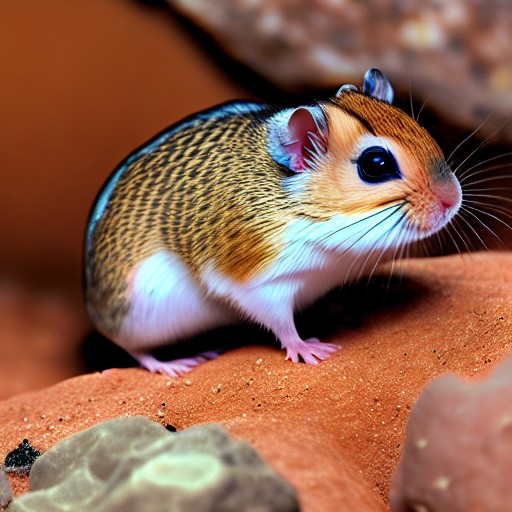Gerbils are adorable and fascinating small rodents that are commonly kept as pets. They are known for their cute and bushy tails, which are an important part of their anatomy and play a significant role in their locomotion, balance, and communication. However, have you ever wondered whether a gerbil can lose its tail? If so, what are the reasons behind it, and how does it affect the health and behavior of the gerbil? In this article, we will explore these questions in detail and provide you with all the information you need to know about the tail loss in gerbils.
Gerbils are members of the rodent family, which also includes rats, mice, hamsters, and squirrels. They are native to the arid regions of Africa and Asia and have adapted to survive in harsh environments. Gerbils are known for their burrowing behavior, social nature, and acrobatic skills. They also have a distinctive tail that sets them apart from other rodents. However, like all living beings, gerbils are vulnerable to various health issues and injuries, including the loss of their tails.
Can a Gerbil Lose Its Tail?
Anatomy of a Gerbil Tail
Before we delve into the topic of tail loss in gerbils, let’s first understand the anatomy of a gerbil tail. A gerbil’s tail is a long and slender appendage that is covered with fur and has a bushy tip. The tail is made up of several vertebrae, muscles, nerves, and blood vessels. It serves several functions, including balance, coordination, thermoregulation, communication, and defense. Gerbils can move their tails in various directions and use them to signal their emotional state, such as agitation, curiosity, or excitement.
Can Gerbils Lose Their Tails Naturally?
Gerbils, like many other animals, can naturally shed their tails as a means of defense or regeneration. This process, known as autotomy, involves the voluntary detachment of the tail from the rest of the body. However, unlike lizards, which can regenerate their tails after autotomy, gerbils cannot grow back their tails once they have lost them. Therefore, tail loss in gerbils can have permanent consequences.
Traumatic Tail Loss in Gerbils
One of the most common causes of tail loss in gerbils is traumatic injury. Gerbils can injure their tails in various ways, such as getting caught in a cage wire, getting bitten by another gerbil or pet, or being dropped or stepped on accidentally. Traumatic tail loss can cause pain, bleeding, and shock to the gerbil and requires prompt veterinary attention.
Causes
Some of the common causes of traumatic tail loss in gerbils include:
- Cage accidents, such as wire entrapment, door slamming, or falls from a height.
- Aggressive behavior among gerbils, such as fighting, biting, or chasing.
- Interactions with other pets, such as cats, dogs, or birds of prey.
- Accidental mishandling by humans, such as dropping, stepping on, or pulling the tail.
Symptoms
The symptoms of traumatic tail loss in gerbils may include:
- Bleeding from the tail or the wound site.
- Limp or crooked tail.
- Pain or discomfort, which may cause the gerbil to become irritable or lethargic.
- Shock, which may cause the gerbil to exhibit shallow breathing, pale gums, or low body temperature.
Treatment
If your gerbil has suffered traumatic tail loss, it is essential to seek veterinary attention immediately. The veterinarian will examine the wound and determine the extent of the injury. In some cases, the veterinarian may recommend amputating the tail if it cannot be saved or if it poses a risk to the gerbil’s health. The gerbil will also need antibiotics to prevent infection and pain medication to relieve discomfort. It is crucial to keep the gerbil in a quiet and stress-free environment during the recovery period and monitor its behavior and appetite.
Tail Autotomy in Gerbils
Tail autotomy is a natural phenomenon that occurs in many animals, including gerbils. Autotomy is a self-defense mechanism that allows the animal to escape from predators by sacrificing a body part that the predator can grab onto. In gerbils, tail autotomy can occur under various circumstances, such as stress, fear, or aggression.
Definition
Tail autotomy is the voluntary detachment of the tail from the rest of the body by the gerbil. Autotomy is initiated by the contraction of the muscles that connect the vertebrae of the tail. The tail then breaks off at a predetermined fracture plane, leaving a clean wound that can heal quickly.
Reasons
There are several reasons why gerbils may engage in tail autotomy, including:
- Predation avoidance: Gerbils can escape from predators by detaching their tails, which can distract or confuse the predator.
- Self-defense: Gerbils may use their tails as a defensive tool to distract or repel attackers, such as other gerbils or pets.
- Stress or fear: Gerbils may detach their tails as a result of extreme stress or fear, such as being chased or handled roughly.
- Regeneration: Some studies suggest that gerbils may engage in tail autotomy as a means of regenerating damaged or infected tissue in the tail.
Mechanism
The mechanism of tail autotomy in gerbils involves several steps:
- The gerbil senses a threat or experiences extreme stress or fear.
- The brain sends a signal to the tail muscles to contract.
- The vertebrae in the tail fracture at a predetermined plane.
- The tail detaches from the rest of the body, leaving a clean wound.
- The gerbil escapes from the threat or recovers from the stress or fear.
Implications
Tail autotomy in gerbils can have both positive and negative implications. On the one hand, tail autotomy can help gerbils escape from predators or defend themselves from attackers. It can also facilitate tissue regeneration and prevent the spread of infections. On the other hand, tail autotomy can cause stress, pain, and behavioral changes in gerbils. It can also affect their balance, coordination, and communication abilities. Therefore, it is essential to provide gerbils with a safe and stress-free environment and to handle them gently to minimize the risk of tail autotomy.
Conclusion
In conclusion, gerbils can lose their tails naturally or as a result of traumatic injury or tail autotomy. Tail loss in gerbils can have various implications, depending on the cause and severity of the injury. It is crucial to provide gerbils with a safe and healthy environment and to monitor their behavior and health regularly. If you suspect that your gerbil has suffered tail loss, seek veterinary attention immediately.
FAQs
- Can a gerbil survive without its tail? Yes, a gerbil can survive without its tail, although it may experience some changes in behavior and health.
- How can I prevent my gerbil from losing its tail? You can prevent tail loss in gerbils by providing them with a stress-free environment, avoiding rough handling, and keeping them away from potential predators or aggressive animals.
- Is tail autotomy painful for gerbils? Tail autotomy can be painful for gerbils, but the pain usually subsides quickly after the tail is detached. However, the gerbil may experience discomfort and behavioral changes during the recovery period.
- Can gerbils regenerate their tails? Gerbils cannot regenerate their tails fully, but they may engage in tail autotomy as a means of regenerating damaged or infected tissue in the tail.
- How long does it take for a gerbil’s tail to heal? The healing time for a gerbil’s tail depends on the severity of the injury and the quality of the care provided. In general, it takes about two to four weeks for the wound to heal fully. During this time, the gerbil should be kept in a quiet and stress-free environment and monitored closely for any signs of infection or pain.










